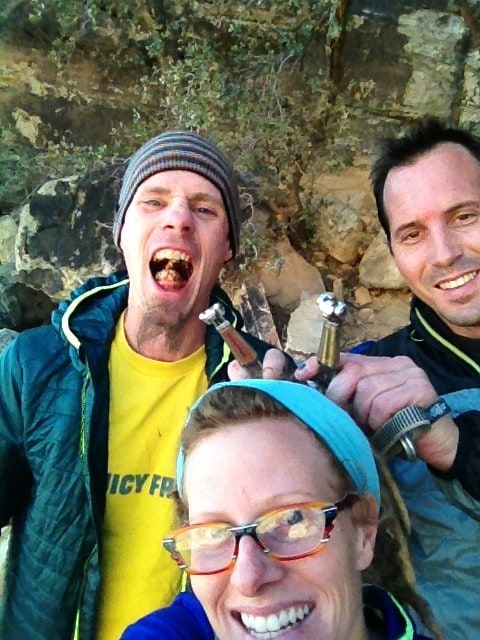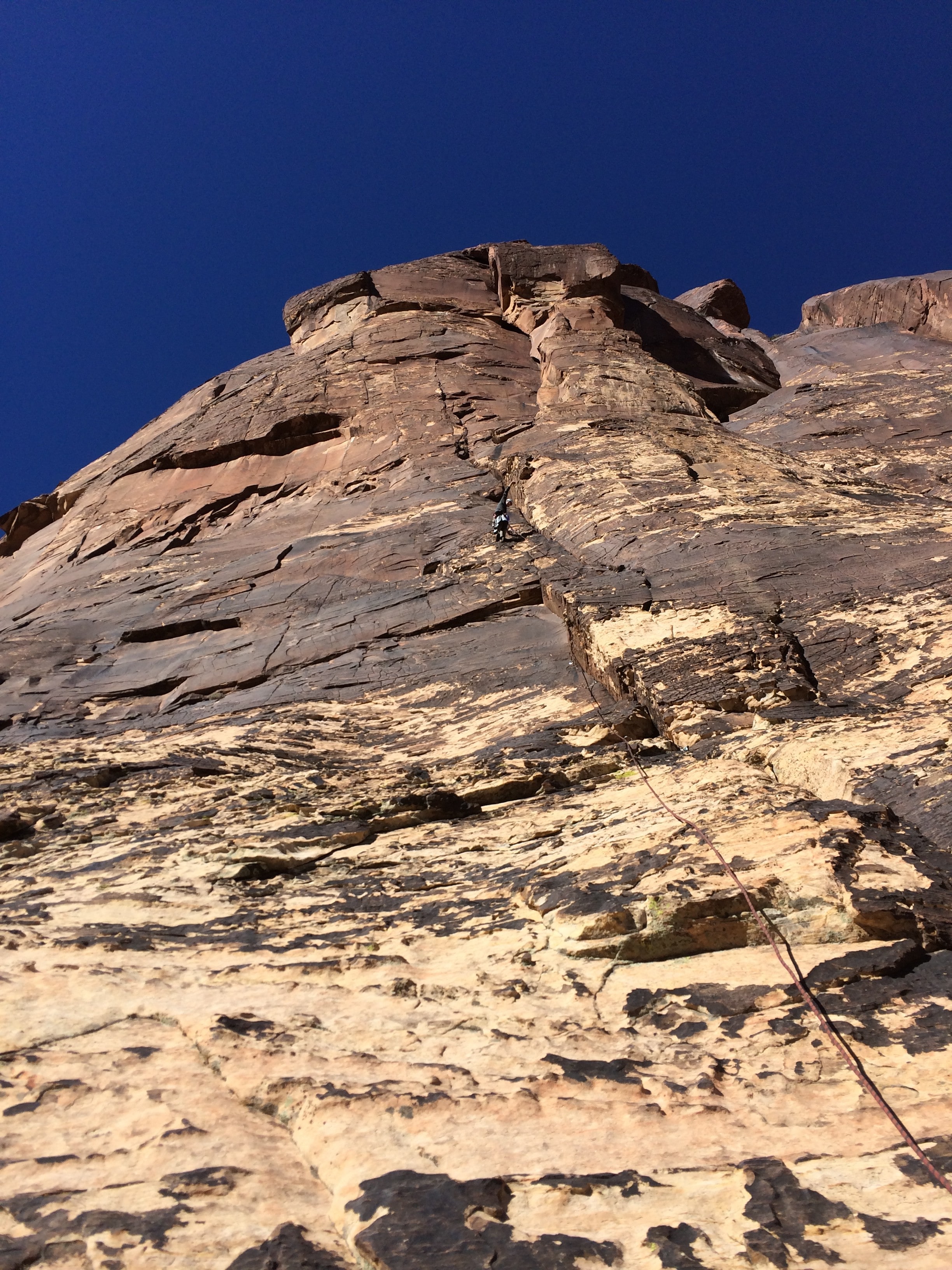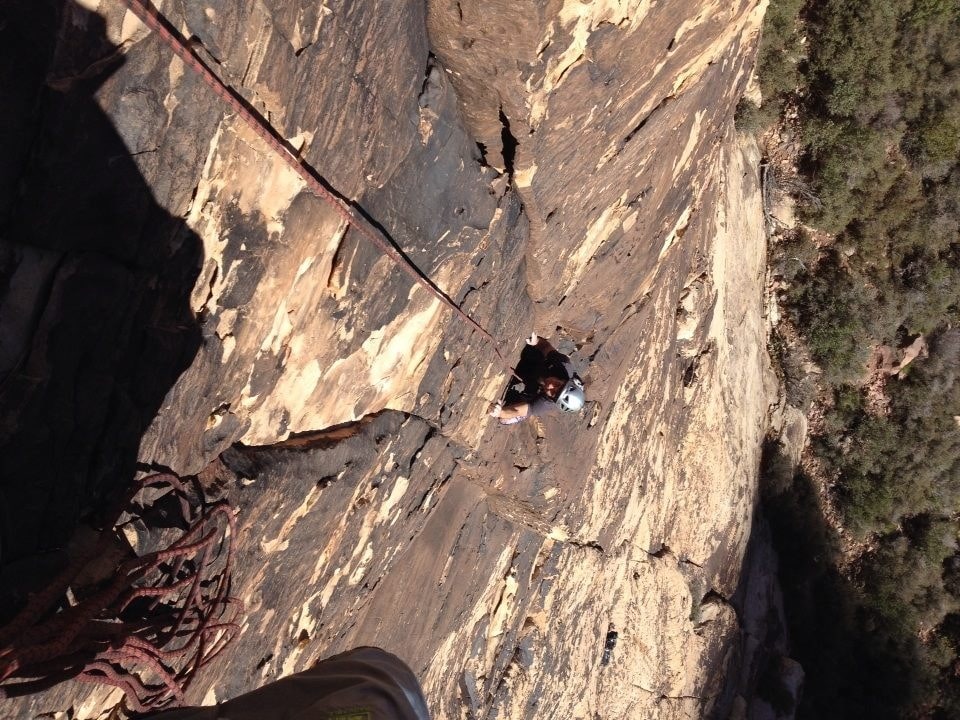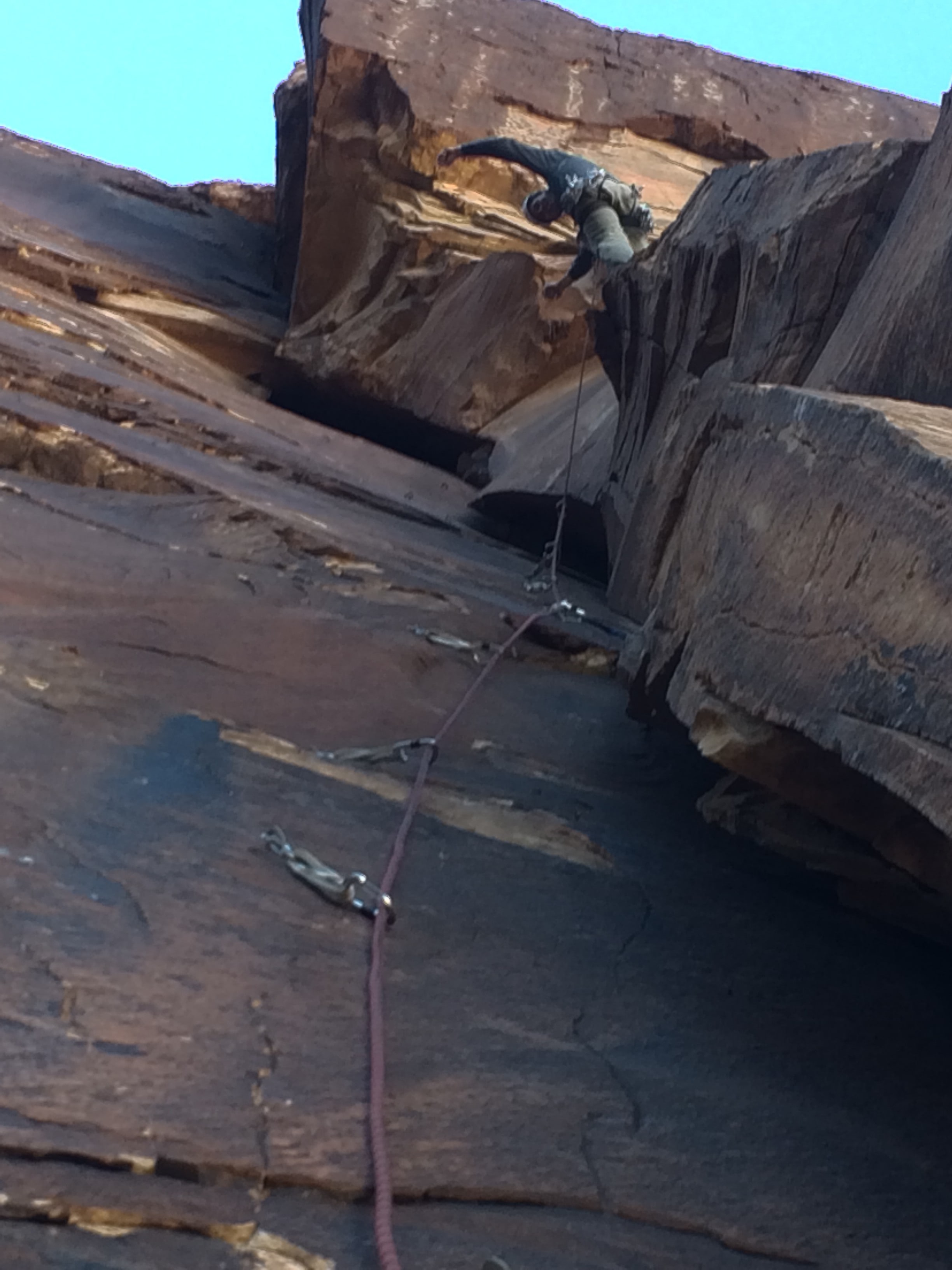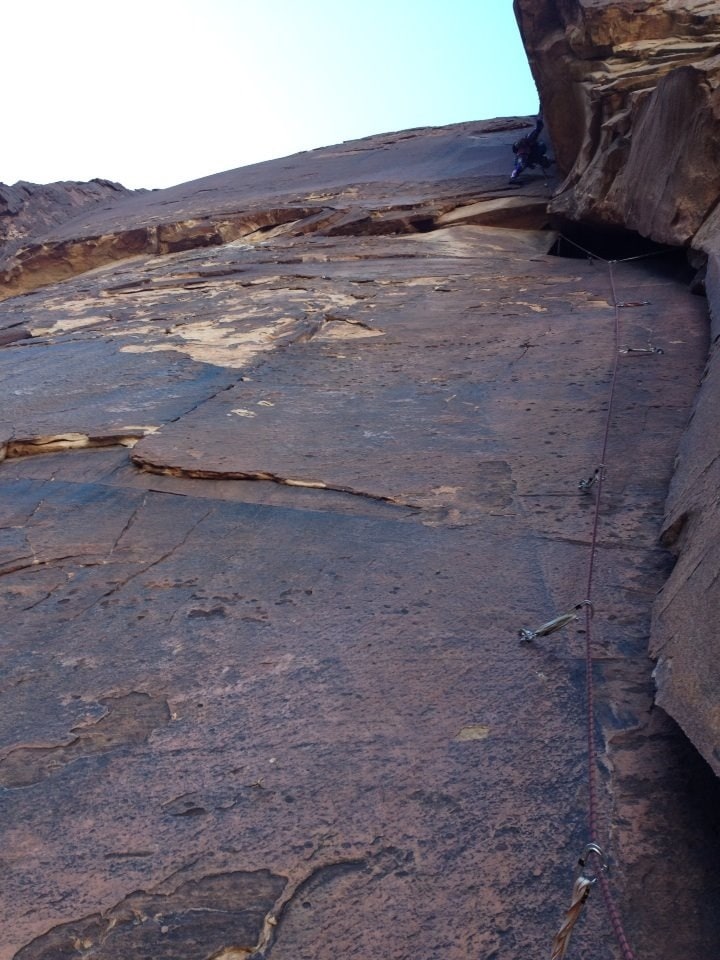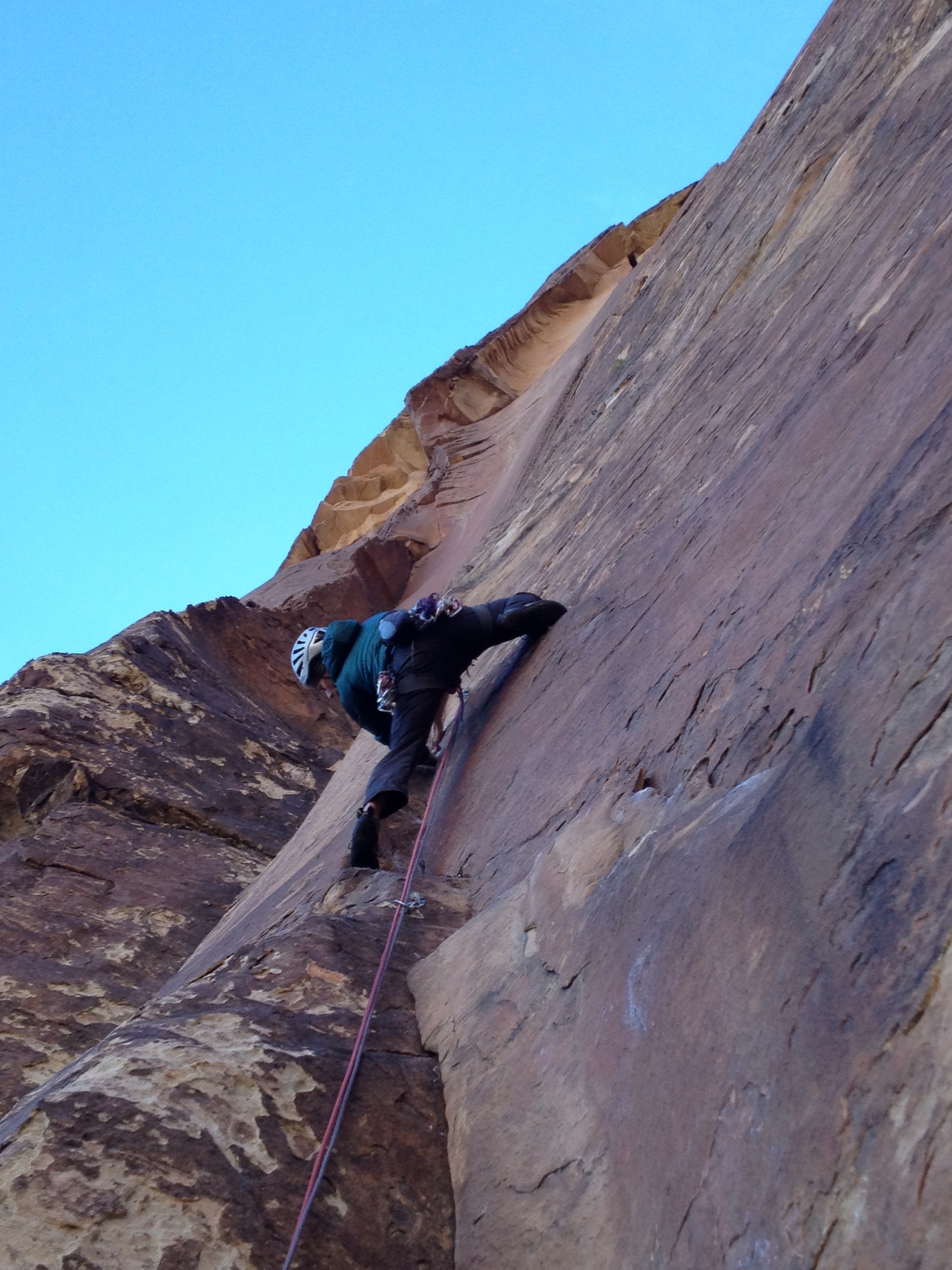Red Rock Mental Games
After weeks of guiding, moving, house renovation (at times I seriously felt like I was on an episode of “Flip that House”), I decided that I needed a break. Since remaining in Joshua Tree and taking a break would undoubtedly lead to working on the house anyways, I headed out of town to the city of Las Vegas. The objectives: climb Time’s Up (5.11+), Ixtlan (5.11c), and spend some quality time with Laura Trejo.
Ash and Randi are two of my great friends. These people are seriously generous and genuine rad climbers, and they have been a great influence in my life ever since the fateful day we met in New Jack City a little over a year ago.
My trip started with an extra early commute Friday morning from Joshua Tree to my Victorville office job (hour and a half commute). I had to make it to work in time for a 6:30 morning meeting, so I was up and on the road by about 4:50 AM. At 3:30 in the afternoon, I was on the road again, this time to Vegas and Red Rock. It was probably the worst traffic I have experienced on the way to Vegas. Not the typical boring bumper to bumper stop and go, or Nascar drafting tail gating at horrific highway speeds, but the type that makes you want to shit your pants when a train of cars ahead of you traveling at 80 mph all slam on their brakes, you in turn slam on yours, and everything inside your vehicle flies forward to a sudden stop against the dashboard of your car. This must have happened 5 or 6 times. I was already extremely tired, and the traffic was the kind of mental taxing that made you want to give up or punch someone in the throat. I was relieved to arrive in Las Vegas in one piece, the only damage being an anticipated shortened life due to mental stress and rattled nerves.
I dropped off some tools at Ash’s house, had a beer with Ash, and proceeded to meet Laura at the Aria casino for a dinner date. Driving through the Las Vegas strip is not for the “defensive driver”. If you drive “defensively”, you will be run off of the road by taxis and tourists. After a few go arounds, I gave up on the idea of finding the parking garage for the Aria and settled on parking at the Cosmopolitan and walking. There is a point at which you realize that walking would actually be much faster than driving, and at that point, frustration begins to morph into desperation. Luckily, I parked just as this transition occurred, and I was able to regain composure to proceed into the Aria. All I can say about Vegas casinos is that they are designed to get you lost. For good. They are huge, and if you haven’t been inside “casino X”, you will regret entering once you have gone more than 25 feet from the entrance. Attempting to find the exit will result in mental anguish and panic. At the 25 foot marker inside casinos, you pass into a crowd of people who are probably hired by the casino to confuse and disorient you. I can’t imagine a fire ever happening in one of these places. It would be mad chaos. I somehow managed to find Laura in the throng of people, and we had an exceptionally ordinary sushi dinner at extraordinary prices. I reminded myself that you are really paying for the atmosphere in these situations. This seems ironic because I find these atmospheres so distracting that any chance of mental focus, zen or peace is lost in a myriad of subjected mental stimulation. This atmosphere represents in whole the huge contrast between the rock climbing community and the population interested in the distractions of Las Vegas. Distraction from whatever situation you are in can be the object of an evening, however I find myself in sensory overload and an overly stimulated mental state that leaves me in a glassy eyed zombie condition until a sense of order and peace is recovered upon simplifying my surroundings (leaving the area).
The next morning I woke up around 5:50. Me and Ash drove to Red Rock and were on the trail to the Brownstone Wall by about 8:00. I was very thankful to have been to this wall before. The trail can be quite confusing as there is no properly marked trail to the wall, but rather a spaghetti dinner mess of intertwining trails and unexpected scrambling events up washes and over boulders leading eventually to the objective climb. We didn’t miss any turns, and the approach still took about 2 hours. We arrived at the bottom of the climb, and I knew that the Aria dinner was either going to come out “right now”, or up on the wall during the off width section. I opted to purge in a more controlled environment at the bottom of the climb, and Ash agreed that I had made a wise decision when he audibly observed the conclusion of this meal. We sprawled out on the rock for about 20 minutes and waited for the sun to creep down the wall towards us and let us climb in the sun. Looking up at the climb, it seemed like a pretty short affair. I could actually see the anchors at the very top of the climb from the ground, and all of the pitches were less than 100 feet. We felt pretty casual about the day.
Ash took the first pitch, a 5.9 face climb up to a corner. We were already about 50 feet up on the wall when we roped up and stashed our bags (easy slab to this point), and I remarked on his “free solo” status when he got another 30 feet up the first pitch without placing any gear. He looked down and said it felt solid. Finally he placed a piece of gear, and I felt a little tension go out of my system. He reached the first corner and proceeded upwards. This climb must not get much traffic, because there wasn’t much chalk anywhere. Route finding made it more of an adventure climb, which can be quite fun. Ash sent the rest of the pitch without event, and brought me up to meet him.
Now it was my turn to lead a pitch. I racked up at the anchor and began up the .10a techy stemming/edging pitch. Red Rock .10a can mean a lot of things. Not as many things as a Joshua Tree .10a, but still a lot of things. This particular pitch ended up being quite sustained with somewhat finicky gear. As I began climbing, I realized that my mental game was not especially keen that day. I was not climbing confidently, I didn’t feel solid, didn’t like the two black aliens I had placed, and the thought of falling actually scared me quite a bit. This is a bad mental place to be. Although the moves were all well within my ability, my brain was screaming at me to stop. During these junctures in life, the “noise” of all the fear in your head can sometimes become overwhelming. It can eclipse all rational thought, and create enormous obstacles in the path to reasoning out a sequence or making solid judgements. In climbing, the ability to deal with this stress effectivly is just as important as the ability to do moves upward. This stress can completely shut down an exceptionally strong climber. However, this stress is also what joins the brain to the body and makes climbing such a fulfilling whole body activity. On this particular day, my ability to process this situation was not up to par. I felt afraid. Very afraid. Once this fear takes hold in your head, it is extremely difficult to “get back to normal” or overcome it. It tends to build, and as it consumes more and more of your rational abilities, it consumes you. I am beginning to believe that the correct course of action in a situation such as this is to take a small fall onto your gear and test out your brain’s theories. A small fall will bring you back to the reality of the situation – you are actually quite safe. Often we experience a feeling of mental relief after taking a small fall. Our brain has promised us this fall will be a screaming plunge to imminent injury. We slip off the rock and scream, and fall 3 or 4 feet and stop. And then we feel silly. But we realize at this moment that our brain is actually magnifying beyond reason the “danger” of the situation. Often, this feeling of relief is followed by a sudden understanding of the actual situation, without the amplified cranial influence, and this understanding brings stress relief and regrounds us. However, on this particular day, I continued up to the anchor, climbing slowly and placing too much gear. As I brought Ash up, he managed to pull a plate sized piece of rock off of the face of the climb and take a 4 foot fall while on top rope. I watched as the plate sized rock hurtled downwards, bounced once, and then disappeared into the brush at the bottom of the climb. I watched Ash’s face transition into a manifestation of what I was feeling while leading; paralyzing fear. Ash continued upwards, and made it to the belay quite shaken.
Now it was Ash’s turn to lead again. This time the pitch was a sustained .11a corner system. This pitch was actually very well bolted, but once fear has taken root in your head, it is very hard to dissipate, bolts or not. Ash headed up the pitch. I watched as he stemmed, side pulled, made good judgement calls and read the rock perfectly. It was beautiful. It was also the hardest trad pitch I had seen Ash lead, and I could tell it took all of his mental and physical effort to continue up the climb in the face of fear and paralyzing brain activity.
At the belay, Ash had a sincere moment of victory. A true moment to call his own, and a moment of realization of what he had just accomplished. Moments such as these are the rewards in climbing, and I celebrated with him. It was monumental, and it was all his.
I climbed up the pitch after him and began realizing how sustained and excellent the corner really was. In the absence of fear, the climb was fantastic. I began to feel a bit better about the day and about the prospect of leading the next .11+ pitch.
I stepped off of the belay, and the same feelings of inadequacy and fear began creeping back into my head. There’s nothing quite like a good ol’ fashioned off width crack to bring the brain’s focus back to the physical realm. After a couple bolts, I looked up at what appeared to be a good run to the next protection. Ugh… here comes my brain again. I made myself squeeze into the chimney and feel the security of the rock against my back, my knees, and my feet. After a few moves, I knew that there was no way I was going to fall out of this chimney. Sometimes, the simple act of initializing into a sequence is all it takes to bring us out of that quandary of cerebrally amplified ridiculousness. As I headed up the final corner to the belay, I was rewarded with a ridiculously fun sequence that made me feel like a stud for figuring out on lead. What an excellent day and what an excellent climb!
The next day, Randi Melvin (Ash’s girlfriend) joined us to climb Ixtlan. Another absolutely beautiful climb on high quality rock. I won’t go into the details, but here’s an picture from the climb (Thanks Randi!):
In summary, the brain plays a very important part of a climber’s ability. It can make the difference between an excellent well balanced mind and body experience, or it can severely limit our abilities by shutting us down. It must be worked in much the same manner as your body, and when it gets “out of shape”, things can get exciting quickly.
January 21, 2014. Posted by: nelsonday
